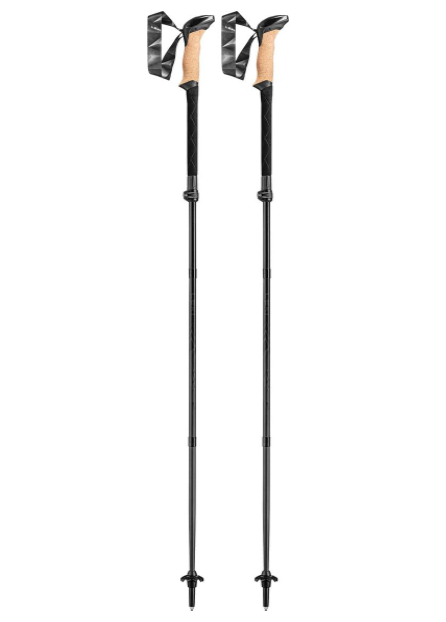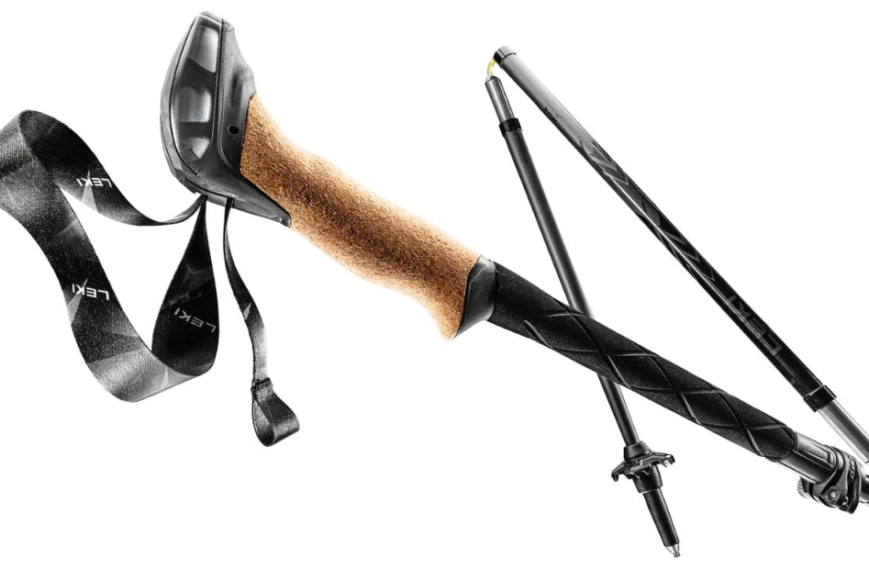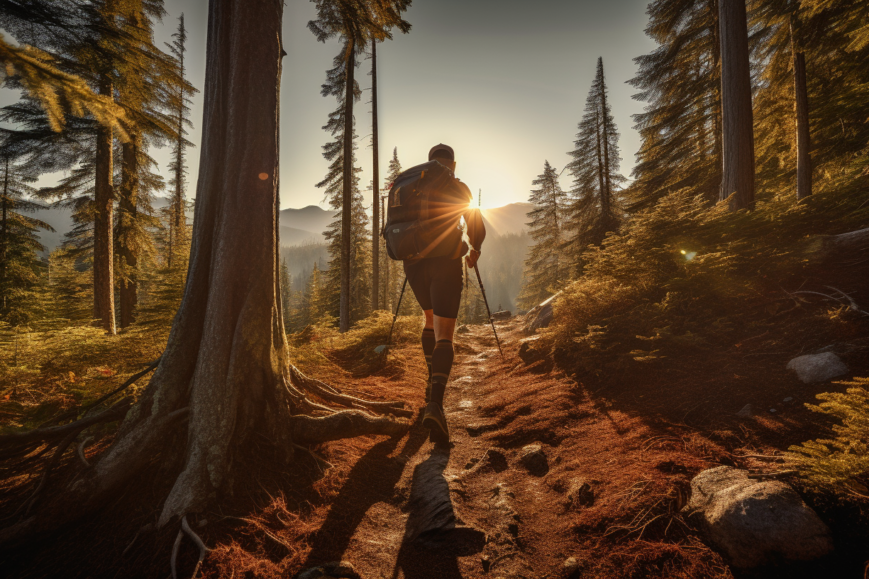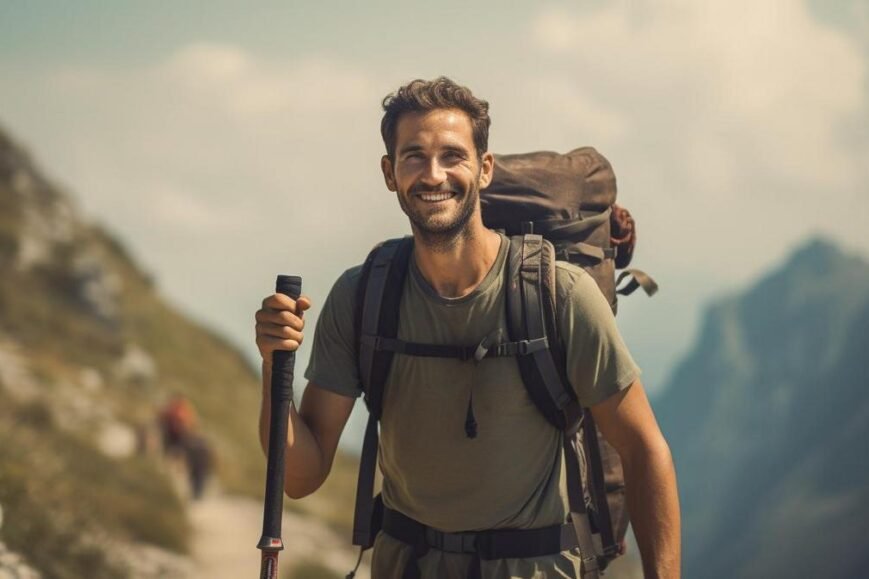Brief Overview
The Leki Black Series FX Carbon trekking pole is a premium outdoor product designed to meet the demands of experienced hikers, mountaineers, and outdoor enthusiasts who seek a reliable, high-performance, and versatile tool for their adventures. As a part of Leki’s renowned line of trekking poles, the Black Series FX Carbon represents the brand’s commitment to delivering exceptional quality, innovative features, and a seamless user experience.
Crafted with a focus on optimizing comfort, stability, and durability, the Black Series FX Carbon sets itself apart in the trekking pole market. Whether tackling rugged alpine trails, traversing challenging backcountry terrain, or embarking on a leisurely day hike, this trekking pole has been engineered to be a trusted and indispensable companion for outdoor adventurers who demand the best from their equipment.
Leki Black Series FX Carbon

Specifications
• Material: 100% Carbon shaft sections
• Shaft Diameter: 16/14/12 mm, conical shaped
• Grip: Aergon Thermo long foam grip with thermal extension
• Strap: Adjustable, breathable Skin strap
• Locking Mechanism: Speed Lock 2 external locking system
• Basket: Trekking 2.0 Flex Tip (interchangeable)
• Tips: Flex Tip Short (carbide tip)
• Packing Size: 64 cm (25 inches)
• Usable Length: 110-130 cm (43-51 inches)
• Weight Per Pair: 435 g (15.3 oz)
• Includes: Storage bag
• Suitable for: 4-season backpacking and trekking, snowshoeing
First Impressions
The first impression of the Leki Black Series FX Carbon trekking pole is one of exceptional quality, sophistication, and attention to detail. The pole’s sleek and modern aesthetic, with its distinctive carbon fiber construction and the prominent Leki branding, immediately conveys a sense of premium craftsmanship and high-performance capabilities.
Holding the Black Series FX Carbon in one’s hands, the immediate sense is one of balance, stability, and comfort. The carbon fiber shaft, coupled with the ergonomic grip, contribute to an overall impression of a product that has been meticulously designed and engineered to provide exceptional comfort and control during outdoor activities.
Closer examination of the Black Series FX Carbon reveals the level of thoughtfulness that has gone into its design. Features such as the shock-absorbing suspension system, the reinforced aluminum tips, and the secure attachment of the wrist strap instantly communicate Leki’s deep understanding of the needs and preferences of outdoor enthusiasts.
The smooth and responsive operation of the trekking pole’s twist-lock adjustment mechanism, coupled with the tactile feel of the grip and the secure attachment of the wrist strap, further reinforces the impression that the Black Series FX Carbon is a product that has been crafted with the user’s experience firmly in mind.
Overall, the first impression of the Leki Black Series FX Carbon is that of a premium, high-performance trekking pole that has been designed and engineered to the highest standards. The combination of its sleek aesthetics, comfortable and stable construction, and innovative features suggests that this product is poised to deliver an exceptional user experience for outdoor enthusiasts who demand the best from their equipment.
What We Like
One of the standout features of the Leki Black Series FX Carbon trekking pole is its exceptional shock-absorption and stability, which are achieved through the integration of the brand’s renowned FX suspension system.
- Shock-Absorption and Stability: The FX suspension system, which utilizes a series of internal springs and dampers, effectively mitigates the impact and vibrations that are typically encountered during outdoor activities, providing users with a more comfortable and controlled experience. This level of shock-absorption is particularly valuable for hikers, mountaineers, and other outdoor enthusiasts who navigate challenging terrain that can be hard on the body, helping to reduce fatigue and minimize the risk of injury.
- Adjustability and Versatility: The product’s twist-lock adjustment mechanism, which allows users to quickly and easily adjust the length of the poles, enables a customized fit that can be tailored to the individual user’s height and the specific demands of the terrain. This adjustability not only enhances the overall comfort and stability of the trekking poles but also allows users to seamlessly adapt to changing conditions or transitioning between different types of terrain.
- Reinforced Aluminum Tips: The inclusion of reinforced aluminum tips, which can be equipped with a variety of interchangeable baskets and ferrules, further adds to the Black Series FX Carbon’s versatility. Users can quickly and easily swap between different tip configurations to optimize the performance of their trekking poles for specific terrain and weather conditions, ensuring that they have the right tool for the job at hand.
- Durability and Weather-Resistance: The carbon fiber construction, combined with the reinforced aluminum components and the weather-resistant design, ensures that the trekking poles can withstand the demands of rugged outdoor use without compromising their performance or longevity. This level of durability and reliability is a key selling point for users who seek high-quality equipment that can accompany them on extended outdoor adventures, regardless of the environmental conditions they may face.
What We Don’t
While the Leki Black Series FX is an exceptional product that excels in many areas, there are a few aspects of the product that may not appeal to all users.
- Price Point: One potential drawback of the FX Carbon is its relatively high price point, which may be a concern for users on a tighter budget or those who are new to the world of trekking poles and may not be willing to invest in a premium-priced product. Although the FX Carbon’s exceptional quality, performance, and features justify its cost, the product may not be the most accessible option for all outdoor enthusiasts.
- Weight: Another potential limitation of the Black Series FX Carbon is its relatively heavier weight compared to some of its carbon fiber competitors. Weighing in at around 18 ounces (510 grams) per pair, the trekking poles may not be the lightest option on the market, which could be a consideration for users who prioritize minimizing the overall weight of their outdoor gear.
- Twist-Lock Adjustment Mechanism: Finally, the Black Series FX Carbon’s reliance on a twist-lock adjustment mechanism, while generally reliable and easy to use, may not appeal to all users who prefer the simplicity and familiarity of a push-button or lever-style adjustment system. While the twist-lock mechanism is designed to provide a secure and precise fit, some users may find it slightly more challenging to operate, particularly in the midst of outdoor activities or when wearing gloves.
The Specs
Key Features:
- Design: The Leki Black Series FX Carbon trekking pole features a sleek, modern, and well-engineered design, with a focus on delivering exceptional shock-absorption, stability, and user-friendly features.
- Dimensions: The Black Series FX Carbon is available in two adjustable length ranges: 100-135 cm (39-53 inches) and 115-150 cm (45-59 inches), allowing users to select the size that best fits their height and preferences.
- Weight: At approximately 18 ounces (510 grams) per pair, the Leki Black Series FX Carbon is a relatively lightweight trekking pole, but not quite as featherlight as some of its carbon fiber competitors.
- Convenient Features: The Black Series FX Carbon boasts a range of user-friendly features, including the twist-lock adjustment system for quick and easy length adjustments, reinforced aluminum tips with interchangeable baskets and ferrules, and an adjustable wrist strap for a secure and comfortable grip.
Overall Performance
Quality
The Leki Black Series FX Carbon trekking pole is seriously some high quality gear, with a level of craftsmanship and attention to detail that is immediately apparent to users. The carbon fiber construction, combined with the reinforced aluminum components and the precise and responsive operation of the adjustment system, contribute to an overall sense of premium, high-performance engineering.
Adjustability
One of the standout features of the Black Series FX Carbon is its exceptional adjustability, which is facilitated by the twist-lock mechanism. The ability to quickly and easily adjust the length of the poles allows users to customize the fit to their individual height and the demands of the terrain, enhancing the overall comfort and stability of the trekking poles.
Durability
The Black Series FX Carbon’s robust carbon fiber construction, combined with its weather-resistant design and reinforced aluminum components, ensures that the product can withstand the rigors of outdoor use without compromising its performance or longevity. This level of durability and reliability is a key selling point for users who demand high-quality equipment that can accompany them on extended outdoor adventures.
Comfort
The Leki Black Series FX Carbon focus on user comfort and ergonomics is another standout aspect of its overall performance. The shock-absorbing suspension system, which effectively mitigates the impact and vibrations encountered during outdoor activities, combined with the secure and comfortable grip, contribute to a user experience that is both efficient and enjoyable, even during prolonged periods of use.
Best Uses
Terrain
The Leki Black Series FX Carbon trekking pole is a versatile and capable tool that can excel in a wide range of outdoor terrains and environments. The product’s stability, adjustability, and interchangeable tips make it well-suited for navigating rugged trails, traversing challenging mountainous landscapes, and tackling a variety of other outdoor settings where a reliable and adaptable trekking pole is essential.
Whether users are embarking on a multi-day backpacking trip, exploring scenic day hikes, or attempting to conquer a technical alpine ascent, the Black Series FX Carbon’s performance and flexibility ensure that it can be an invaluable companion throughout a diverse array of outdoor adventures.
Weather Conditions
The Leki Black Series FX Carbon weather-resistant construction and durable design also make it a reliable choice for use in a variety of weather conditions. The product’s ability to withstand the elements, such as moisture, temperature extremes, and UV exposure, allows it to maintain its performance and functionality in the face of the unpredictable and often harsh conditions that outdoor enthusiasts may encounter.
From navigating snowy trails and traversing icy terrain to braving rainy or windy environments, the Black Series FX Carbon’s dependability and adaptability ensure that users can rely on it as a trusted companion, regardless of the weather conditions they may face.
Comparison to Other Trekking Poles
When compared to other trekking poles on the market, the Leki Black Series FX Carbon stands out for its exceptional shock-absorption, stability, and overall value proposition.
- Black Diamond Alpine Carbon Cork: One notable competitor is the Black Diamond Alpine Carbon Cork, a trekking pole that shares many similarities with the Black Series FX Carbon in terms of its carbon fiber construction and innovative features. However, the Black Series FX Carbon’s emphasis on shock-absorption and its more advanced suspension system give it a slight edge in terms of user comfort and control, particularly for those who prioritize a cushioned and stable feel during their outdoor activities.
- Komperdell Carbon Power Lock: Another trekking pole that warrants comparison is the Komperdell Carbon Power Lock, a product known for its advanced shock-absorbing technology. While the Carbon Power Lock may offer a more sophisticated vibration-dampening system, the Black Series FX Carbon’s combination of shock-absorption, adjustability, and overall durability make it a strong contender for users who seek a well-rounded trekking pole that can handle a variety of outdoor conditions.
- MSR DynaLock Ascent Carbon: When compared to the MSR DynaLock Ascent Carbon, a trekking pole renowned for its lightweight design and adjustability, the Black Series FX Carbon may not be the lightest option on the market. However, the Leki pole’s focus on stability, comfort, and weather-resistance still make it a compelling choice for users who are willing to invest in a premium-quality trekking pole that can withstand the demands of rugged outdoor use.
Our Final Thoughts
The Leki Black Series FX Carbon trekking pole is a truly exceptional product that delivers a premium, high-performance solution for outdoor enthusiasts who demand the best from their gear.
Whether users are seasoned hikers, mountaineers, or newcomers to the world of trekking poles, the Black Series FX Carbon has the potential to become an indispensable companion for a wide range of outdoor activities and adventures.
One of the key strengths of the Black Series FX Carbon is its exceptional shock-absorption and stability, which are achieved through the integration of Leki’s renowned FX suspension system. This innovative technology effectively mitigates the impact and vibrations encountered during outdoor activities, providing users with a more comfortable and controlled experience that can help reduce fatigue and minimize the risk of injury.
The Black Series FX Carbon’s impressive adjustability, facilitated by the twist-lock mechanism, further enhances its versatility, allowing users to customize the fit to their specific needs and the demands of the terrain. The inclusion of reinforced aluminum tips, with interchangeable baskets and ferrules, also gives users the flexibility to adapt the trekking poles to a wide range of surfaces and conditions, ensuring optimal performance and traction throughout their outdoor adventures.
While the Black Series FX Carbon’s relatively high price point and slightly heavier weight compared to some of its competitors may be a concern for some users, the product’s exceptional quality, performance, and feature set justify the investment for those who are willing to make the financial commitment. For outdoor enthusiasts who demand the best from their equipment and are willing to pay a premium for a trekking pole that delivers uncompromising capabilities, the Black Series FX Carbon is a truly exceptional choice.
In conclusion, the Leki Black Series FX Carbon trekking pole is a remarkable product that sets a new standard for shock-absorption, stability, and user-friendliness in the world of outdoor equipment. Whether users are embarking on a challenging multi-day trek, navigating technical mountainous terrain, or simply seeking a reliable and comfortable companion for their day hikes, the Black Series FX Carbon is a must-have addition to their outdoor gear that is sure to enhance their overall experience and enjoyment of the great outdoors.
FAQ
1. What makes the Leki Black Series FX Carbon trekking pole stand out from other trekking poles?
The Leki Black Series FX Carbon stands out due to its exceptional shock-absorption, stability, and overall quality. The integration of the FX suspension system, carbon fiber construction, and reinforced aluminum components make it a premium choice for outdoor enthusiasts who demand the best from their gear.
2. How does the FX suspension system benefit users?
The FX suspension system utilizes internal springs and dampers to effectively mitigate impact and vibrations, providing a more comfortable and controlled experience. This is particularly valuable for hikers and mountaineers navigating challenging terrain, as it helps reduce fatigue and minimize the risk of injury.
3. Is the Leki Black Series FX Carbon trekking pole suitable for all weather conditions?
Yes, the Leki Black Series FX Carbon is designed to withstand a variety of weather conditions. Its weather-resistant construction and durable design ensure that it can maintain performance and functionality in the face of moisture, temperature extremes, and UV exposure.
4. What are the main drawbacks of the Black Series FX Carbon trekking pole?
The main drawbacks include its relatively high price point, slightly heavier weight compared to some competitors, and reliance on a twist-lock adjustment mechanism, which may not appeal to all users.
5. How does the Black Series FX Carbon compare to other premium trekking poles?
When compared to other premium trekking poles like the Black Diamond Alpine Carbon Cork, Komperdell Carbon Power Lock, and MSR DynaLock Ascent Carbon, the Leki Black Series FX Carbon excels in shock-absorption, stability, and overall durability, making it a strong contender for users seeking a well-rounded and high-performance trekking pole.
![]()







